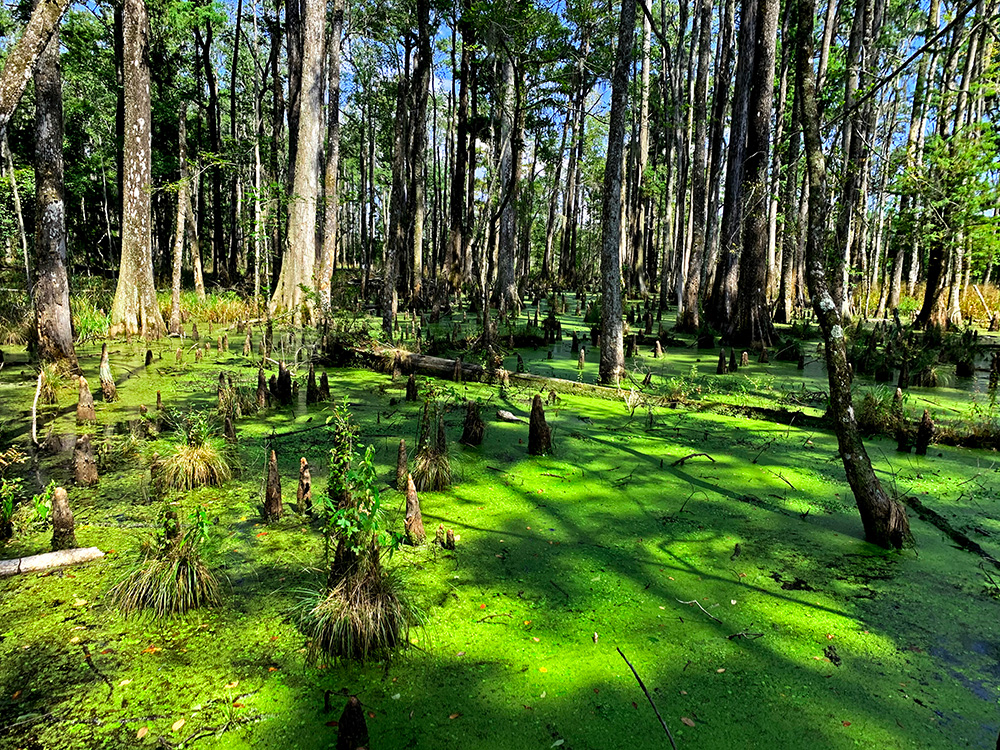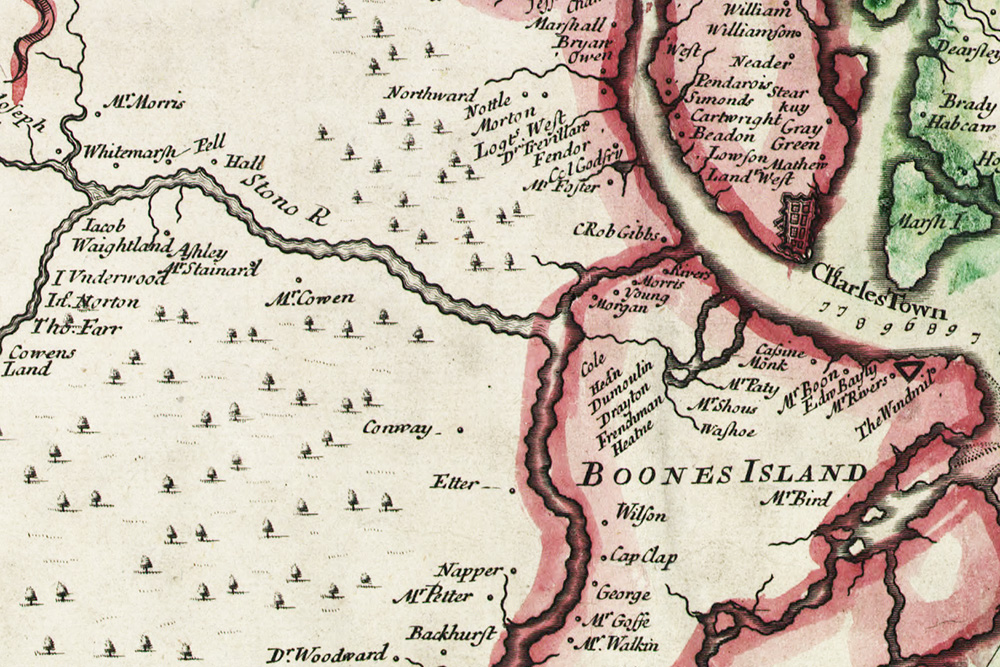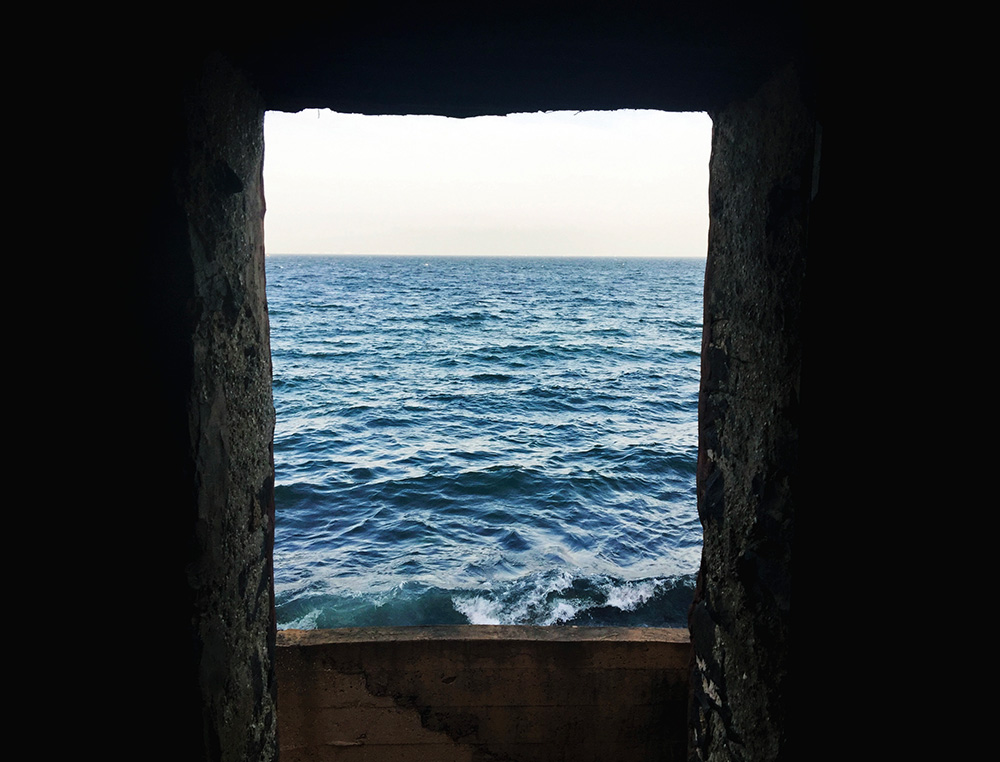Where did Jalen Coats’s ancestors first set foot on US soil? It might have been Charleston, South Carolina. As with so many Black American families, there is no way to know. No record. Not even a monument to their history. As Jalen found on a trip to visit the site of the Stono Rebellion, “ancestry travel” can provide some answers, but it also raises new questions.
“Should I be worried about alligators?” I ask the desk attendant after skimming exhibits about slave trade routes flanked by taxidermied otters. She and I are alone in the only staffed building at the Caw Caw Interpretive Center, a former rice plantation turned wildlife preserve that spans over 600 acres of swampland outside of Charleston, South Carolina. She hands me a brochure and says, “If there are alligators, they’ll hurry off the path when they hear you coming.”
About a quarter mile into the hike, the map and I agree to disagree and I fold it into my pocket. I follow the dirt trail damp with quiet onto the crunch of gravel before turning into an aperture framed by tall grass. Ahead, a kiosk reads, “The 1739 Slave Rebellion occurred here.” There’s a diagram of the probable layout of the main house and outbuildings based on the elevation. I look out to the absent space where willows hover over lush meadows and picture a stately white house with chipping paint and sheer curtains peering through half open shutters — the kind of place I’ve seen in movies — as if from memory.
I’m just minutes from Charleston’s port where my Black ancestors likely landed on this country’s shores in bondage. But standing in the stillness of this bog, surrounded by the algae-coated waters of cypress swamps — it almost feels like another country. I’d come to the Caw Caw Interpretive Center for the same reason I’d come to South Carolina: in search of clues to my Black ancestors’ stories; in that mire, I felt like I was stepping into one. Were the vultures as hushed and the lichen as bright on the eve of what would become the largest slave rebellion in the thirteen colonies? I imagined people who were, or nearly were, my ancestors, wading through the neon green film in the pitch black of night. I imagined they knew exactly which way to go.

It turns out that the Stono Rebellion was almost nothing like I’d imagined. Where there’s now dense brush, 283 years ago would have been wide open. Now, you can’t see very far in any direction without having to peer between tree trunks; then, your view would have been unobstructed for miles. In addition to the fact that white European settlers wanted land cleared for rice cultivation, timber was a busy industry. Enslaved people were tasked with cutting down thousands of acres of longleaf pine and cypress trees using axes and hand saws, and the timber was used to build structures on the property or, among other things, ships for transatlantic trade. Where I had pictured shadows slipping from behind the cover of one tree to another, there had been a movement unfolding out in the light of day, more like a celebration than a secret, more like a riot than a tryst.
Though clearly the result of meticulous planning, the Stono Rebellion — once underway — was not an exercise in stealth. The dozens of rebels shouted chants and drank booze. They carried guns and a banner that read “LIBERTY.” At different points in their revolt, they played drums: the echo an invitation to potential comrades to join the fight for freedom. The goal was seemingly to make it to St. Augustine, Florida, where the Spanish were antagonizing the British by promising freedom to enslaved people who reached their territory and accepted the Catholic religion. But it does not appear to have been a single-minded mission. At one point, the rebels marched north toward Charleston, where they killed a white slaver and his family, before pivoting south. “They must have had some kind of vendetta,” says Thomas Thornton, the Caw Caw Interpretive Center’s facility manager and a retired high school teacher. “Because that was the wrong direction.”
On the acreage where the Caw Caw Interpretive Center now sits, on that specific Sunday in September of 1739, there were two plantations belonging to the Rose and Elliott families. In this part of the Lowcountry, enslaved people could typically spend Sundays tending to their own gardens, hunting, fishing, and working on crafts. White plantation owners did not generally live in the rural areas where rice fields were year-round, because their odds of surviving the conditions that plagued summers in the swamp were low. In fact, that September of 1739, the Charleston area was still reeling from a dangerous bout with yellow fever that Lieutenant Governor William Bull estimated killed six people a day.
The relative independence of Africans and their descendants in coastal South Carolina is thought to be a primary reason for the richness of the Gullah Geechee culture: the distinctive language, food, crafts, and customs of the Black Carolina Lowcountry. But despite being more independent, they weren’t left alone. “Key men,” so-called because they typically had access to several plantations in an area, would ride from plot to plot, working as satellite managers for absentee slavers. There was also the slave driver: an enslaved person assigned with keeping their fellow enslaved people on task in exchange for privileges like less back-breaking work.

The 1739 Slave Rebellion occurred here. “Occurred here” is a bit of a generalization. The rebellion had started “down the road a bit,” says Thornton, off what is now Highway 17. The rebels marched to present-day Caw Caw, where there ensued not a quiet conspiracy but a shootout. A Black man named July hid the white family who enslaved him, and defended their plantation with gunfire, killing one of the rebels. Later, a legislative committee recommended that the governor grant July his freedom, “as a reward for his faithful Services and for an Encouragement to other Slaves to follow his Example in case of the like Nature.” In addition, they suggested he be gifted “a Suit of Cloaths, Shirt, Hat, a pair of stockings and a pair of Shoes.” We do not know if July was a slave driver, but we know he would qualify as the kind of archetypal character inspired by the slave driver. The Uncle Ruckus of The Boondocks, the Stephen of Django Unchained.
I do not know for sure that my family was in South Carolina, having only been able to trace us back to Murfreesboro, North Carolina in 1867 on one side and around that same time in Caroline County, Virginia on the other. About 40 percent of captive Africans brought to the US entered through Charleston. Over the next 200 years of what’s been called the slave-breeding industry, the Black population in South Carolina quadrupled, leaving some historians to conclude that as many as ninety percent of African Americans in the US today can trace an ancestor back to the busiest port of the time. So there are odds, and odds are information. I’d followed generations of research before hitting what genealogists call the “1870 brick wall” — so named because it was the first year that Black people who were enslaved in this country were counted on the census as people rather than property. Prior to 1870, most Black Americans were identified only on slave schedules, as a check mark, maybe an age, and, rarely, a single name.
Several years ago, in Marseille, a boy with charcoal-colored hair and an Algerian father asked me where my people were from. “We’ve been in the USA for centuries, as far back as I can go,” I told him. “No, but where are you really from?” he asked. I searched his face for any sign of disingenuousness; found his large eyes looking back at me curiously. “You have heard of slavery in the Americas — you do know what happened, right?” I asked. “Sure.” “Ok, so that means I don’t know where my family is from.” He looked almost incredulous at the literalness of it all. Did he think I was exaggerating?
How do you explain just how literal not knowing is?
Of course, some Black people in America do manage to recover their histories despite the dearth of resources and lack of official support. But most hit a brick wall somewhere in the Lowcountry or the Delta, left to seek the story from the whispers of the water, the rustling of the leaves.
Toni Morrison said she wrote Beloved to stand in for the monument to enslaved people that didn’t exist. “There is no place you or I can go, to think about or not think about, to summon the presences of, or recollect the absences of slaves,” she said in 1988; “nothing that reminds us of the ones who made the journey and of those who did not make it. There is no suitable memorial or plaque or wreath or wall or park or skyscraper lobby. There’s no 300-foot tower. There’s no small bench by the road.” Twenty years later, the Toni Morrison Society dedicated the first “bench by the road” on Sullivan’s Island in South Carolina. The New York Times covered it in an article titled “Bench of Memory at Slavery’s Gateway.”
“Finish this thought,” says the bench by the road. “Imagine what I mean.”
Nearly 30 miles east of Caw Caw, I spent about an hour searching for the bench on Sullivan’s Island, which was not by the road at all, trying to piece together its location from tidbits on the internet. I eventually found it: a little black steel thing sitting on a slab of concrete, a small plaque on its back and a large one at its feet, the latter of which quotes Morrison’s musings. I sat for a while and looked out at the water. At that site, Africans had been forced to quarantine in “pest houses” upon their arrival, to ensure that any diseases they may have had would either dissipate or kill them before they could spread. The bench was not a book, but still struck me as an object that was standing in for something else. An invitation to consider a narrative that wasn’t being told. An opportunity to contemplate the lives sacrificed to the land and to the ocean with its endless horizon and its shore just steps away. An ellipsis.
Mary Oliver calls the ellipsis “a construct of weakness.” The ellipsis, she writes, is “trying to imply a weighty ‘something’ that has not been said but that the poet wants felt.” It would be, seemingly, less weak to try to express that weighty something. Oliver is talking about poetry and not about the utilitarian ellipsis used to indicate omitted text, nor about gestures or symbols–though the ellipsis of Oliver’s ire is a kind of generalized symbol for “but there’s more…” Those three dots say: “imagine what else I might mean.” In poetry, where finding the right word is half the point, that may not be very desirable, but off the page, in the world of gestures, it might be rather productive. “Finish this thought,” says the bench by the road. “Imagine what I mean.”
At the Maison des Esclaves on Gorée Island, Senegal, nearly 4100 miles east of Sullivan’s Island, I saw the chains, isolation chambers, and torture implements that were used on enslaved people. Originally built around 1776, slavers imprisoned Black captives in dank cells throughout the maison before forcing them onto ships headed for the New World. I peered at the Atlantic Ocean through a rectangle carved into the side of the red clay-colored house. The sky looked faintly warm with sunlight at the horizon while the waves lapped the rocks just below. A beautiful site? The last sight so many Africans would have seen from the vantage point of their homeland.

When I looked out from the Door of No Return, I didn’t know that some historians had decided it, too, was a symbol. The result of a “sincere fiction” and subject of heated debate since at least the 1980s, the House of Slaves, some argue, was most importantly the private residence of a wealthy family. Some argue that a relatively small percentage of enslaved Africans disembarked from the location, while others argue that the House never contained “slaves of trade” at all. The reigning narrative, which claims enslaved people passed through the House in the millions, is thought to be the work of Léopold Senghor appointee, Boubacar Joseph Ndiaye. Ndiaye served as curator to the site for decades, shaping its interpretation amid the affirmation of diasporic blackness emanating from Senghor’s negritude movement, and “remembrance” recommendations from UNESCO. These were among the factors that led to the crystallization of the whole idea of a “gateway” to the New World — in Gorée, but also at Elmina Castle in Ghana and Ouida in Benin. Duly influential was Alex Haley’s Roots, which was published as a novel in 1976 and adapted into a widely-watched television miniseries the following year. Haley’s story is partly responsible for the boom in heritage-based tourism that saw Black Americans crossing the Atlantic due east in search of more information about where their people came from.
I can’t claim to have chosen a trip to Senegal based on any particular desire to discover more about my family’s history. It was, of course, in the back of my mind that this location was not insignificant to the slave trade, but I was not knowingly engaged in what’s come to be known as ancestry travel. I was compelled by a confluence of impressions I couldn’t quite name: the poetry and political theories of black Francophone thinkers who I imagined convening in the walled-in gardens of Dakar, legs crossed, cigarettes-in-hand, discussing African independence and black power; photographs of seemingly-secret swimming holes off the rocky coast; videos of black people in dark suits and bright dresses gliding through the sand-dusted alleyways that snaked between skyscrapers by the sea.
The year that Roots aired on ABC, the Caw Caw Interpretive Center was managed for hunting. The acreage that became the park started as Native American territory, then was colonized in the early 18th century with land grants: that nifty government-backed wealth transfer that encouraged Europeans to settle in what would become the US by essentially giving them land for free. After that, there was a series of hand-changings and property-line-shiftings due to purchases, marriages, inheritances and the like. Over the course of hundreds of years after the Stono Rebellion, the land was used for rice fields, a tea farm, vegetables, livestock, hunting, and, finally, an interpretive site. It was almost a golf course. But hired consultants advised Charleston County that anything other than an interpretive site would be contrary to the land’s best use. The area is too unique historically and archaeologically, they said; plus, it holds all the coastal plain habitats within one square mile.
When I looked at the “occurred here” kiosk again, off the edge of the meadow where the main house and outbuildings would have been, I noticed a section of the rendering labeled “Cemetery.” I walked over to the area that I thought the map was referring to. What was, on the map, a cream-shaded open space next to a bush was, in real life, a piece of land where grass was growing in the same way that grass was growing indiscriminately throughout the reserve. There were no headstones or indications otherwise that there were bodies buried beneath the earth.
Thinking about it now, I ask myself: Was the cemetery a symbol? A “memorial” like the Door of No Return? A bench by the road? I do not personally know the people who are buried there; I do not even know for sure that they are buried there. But at the same time, I know. I know that if not there, then here; if not in 1776 then five years later; if not in Charleston, then in Murfreesboro. Intuition. Imagination. These have to be as important to me as information. How else would I even attempt to answer the question I asked myself as I looked out onto the seemingly mundane, comparatively small section of the park that was the “cemetery”: What does this mean?
(Top photo: Toni Morrison’s “Bench by the Road” on Sullivan’s Island by Ron Cogswell)
